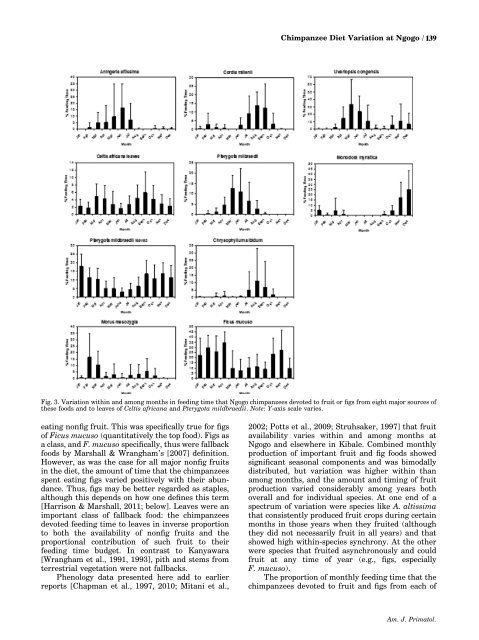Diet of chimpanzees (Pan troglodytes schweinfurthii) at Ngogo ...
Diet of chimpanzees (Pan troglodytes schweinfurthii) at Ngogo ...
Diet of chimpanzees (Pan troglodytes schweinfurthii) at Ngogo ...
You also want an ePaper? Increase the reach of your titles
YUMPU automatically turns print PDFs into web optimized ePapers that Google loves.
10 / W<strong>at</strong>ts et al.<br />
Fig. 3. Vari<strong>at</strong>ion within and among months in feeding time th<strong>at</strong> <strong>Ngogo</strong> <strong>chimpanzees</strong> devoted to fruit or figs from eight major sources <strong>of</strong><br />
these foods and to leaves <strong>of</strong> Celtis africana and Pterygota mildbraedii. Note: Y-axis scale varies.<br />
e<strong>at</strong>ing nonfig fruit. This was specifically true for figs<br />
<strong>of</strong> Ficus mucuso (quantit<strong>at</strong>ively the top food). Figs as<br />
a class, and F. mucuso specifically, thus were fallback<br />
foods by Marshall & Wrangham’s [2007] definition.<br />
However, as was the case for all major nonfig fruits<br />
in the diet, the amount <strong>of</strong> time th<strong>at</strong> the <strong>chimpanzees</strong><br />
spent e<strong>at</strong>ing figs varied positively with their abundance.<br />
Thus, figs may be better regarded as staples,<br />
although this depends on how one defines this term<br />
[Harrison & Marshall, 2011; below]. Leaves were an<br />
important class <strong>of</strong> fallback food: the <strong>chimpanzees</strong><br />
devoted feeding time to leaves in inverse proportion<br />
to both the availability <strong>of</strong> nonfig fruits and the<br />
proportional contribution <strong>of</strong> such fruit to their<br />
feeding time budget. In contrast to Kanyawara<br />
[Wrangham et al., 1991, 1993], pith and stems from<br />
terrestrial veget<strong>at</strong>ion were not fallbacks.<br />
Phenology d<strong>at</strong>a presented here add to earlier<br />
reports [Chapman et al., 1997, 2010; Mitani et al.,<br />
Am. J. Prim<strong>at</strong>ol.<br />
Chimpanzee <strong>Diet</strong> Vari<strong>at</strong>ion <strong>at</strong> <strong>Ngogo</strong> /<br />
139<br />
2002; Potts et al., 2009; Struhsaker, 1997] th<strong>at</strong> fruit<br />
availability varies within and among months <strong>at</strong><br />
<strong>Ngogo</strong> and elsewhere in Kibale. Combined monthly<br />
production <strong>of</strong> important fruit and fig foods showed<br />
significant seasonal components and was bimodally<br />
distributed, but vari<strong>at</strong>ion was higher within than<br />
among months, and the amount and timing <strong>of</strong> fruit<br />
production varied considerably among years both<br />
overall and for individual species. At one end <strong>of</strong> a<br />
spectrum <strong>of</strong> vari<strong>at</strong>ion were species like A. altissima<br />
th<strong>at</strong> consistently produced fruit crops during certain<br />
months in those years when they fruited (although<br />
they did not necessarily fruit in all years) and th<strong>at</strong><br />
showed high within-species synchrony. At the other<br />
were species th<strong>at</strong> fruited asynchronously and could<br />
fruit <strong>at</strong> any time <strong>of</strong> year (e.g., figs, especially<br />
F. mucuso).<br />
The proportion <strong>of</strong> monthly feeding time th<strong>at</strong> the<br />
<strong>chimpanzees</strong> devoted to fruit and figs from each <strong>of</strong><br />
Am. J. Prim<strong>at</strong>ol.


